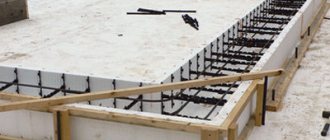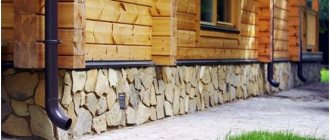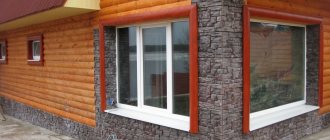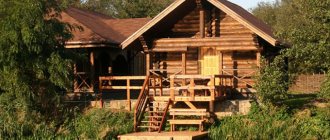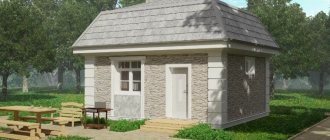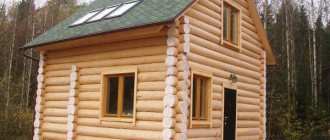Private developers often try to speed up the construction of buildings on their sites, so they often use unconventional construction technologies. One of them includes a foundation made of barrels, which involves a formless version of the foundation for the structure. The result is point supports - buried or installed on sand pads directly on the ground surface. This method has many fans and opponents, each of which has its own arguments and assumptions. But the fact remains that a method of constructing a foundation from concrete-filled barrels exists, although it has some limitations.
Foundation made of barrels filled with concrete
- Technology SP Lectures TSP TSP
- Earth robots
- Scrapers
- Complex mechanized work
- Organization of construction processes using the flow method
- Execution of work by earth-moving machines
- Transportation and compaction of soil
- Concrete work in irrigation and drainage construction
- Construction of irrigation canals
- Construction of earthen dams
- Construction of hydraulic transmission units
- Construction of main structures of waterworks
- Brushwood and gabion work
- Technology of building a pumping station for an abraded plot
- Lectures OSP System of water management organizations and their functions
- Project for organizing the drying system
- Foam concrete
- Perspective-6
Main menu
- home
- Safety precautions
- Pumping units
- GTS Part 1
- Part 2
Construction works
- Road repair
- Excavation
- Underwater concreting
- Highway design
- Construction of highways
- Water supply device
- Ceramics in the home
- Transport work in construction
- Concrete works
- Electricity in the house
- Sewage device
- Warm floor
- Light metal structures
Features of pouring a foundation from barrels
Concrete can only be poured into barrels whose lids have been removed.
If you have to work with a welded barrel, then you can get rid of the lid by cutting. The shell must be mounted at the site of the building's support; in the future it will act as formwork. You will need approximately 4 or more similar support points. Table of components for making concrete mixture.
After the concrete for pouring the foundation is ready, it can be poured into the shells. Reinforcement can be done with steel rods. Waterproofing must be laid in two layers on the surface of the barrels. It is preferable to use roofing material for this.
Ultimately, it will be possible to obtain point supports on which the lower crown of the walls will be mounted. It is permissible to bury the shells into the soil up to the freezing line. Whereas, if the installation is carried out without deepening, a compensation cushion should be installed under them; the thickness of the sand layer should be 10 cm or more.
Table for determining the grade of concrete based on its strength.
Work must begin with marking and leveling the soil on the site. Markings should be made using the method of pulling cords, after which the location of the barrels should be marked. They should be lubricated with used oil before installation.
The remaining space between the walls and the soil of the pits, in the last of which the barrels are installed, should be filled with sand and compacted. Filling the barrels with concrete is done in one step, this will eliminate the possibility of further delamination of the material. It will not be difficult to make such a foundation manually; the main requirement is the preparation of barrels, which can sometimes be problematic.
Stages of work
The top of the barrel must be removed. The removable lid is simply removed, and the circle is completely cut off from the closed container. You can leave the bottom of the barrel; there is no need to get rid of it. The prepared casings are installed on a prepared, leveled base at the corners of the building, at the junction of load-bearing walls, and, if necessary, in the spaces between already installed foundation supports.
First, markings are made by stretching cords around the perimeter of the structure. They will serve as a guide for correctly determining the location of the barrels in the plan. Separately, under each container, a small pit is dug to the depth of the underground structure, to the bottom of which, in stages:
- a leveling sand cushion 10-15 cm thick is added;
- roofing felt is laid in 1-2 layers as waterproofing;
- metal shells lubricated with waste oil are installed.
After backfilling the pits with a sand mixture with layer-by-layer wetting and compaction, they begin to fill the containers with concrete. The reinforcing mesh provided in the design is laid and fixed in metal shells in advance. Each barrel should be filled with the solution at a time, otherwise uneven setting can lead to delamination of the concrete monolith, which is unacceptable. Work on pouring the foundation is most often done manually, since concrete pumps are quite rare in private farms, and installing special gutters is not always a rational solution.
Experts recommend organizing the construction process in such a way that the “barrel” foundation does not remain unloaded during the winter period. Otherwise, after the soil thaws, there will be a possibility that the position of the filled containers will change.
Waterproofing is laid on top of the concrete barrels, protecting the walls from moisture penetration into the ground part of the building. For this, traditional roofing felt laid in two layers is most often used. The finished foundation is tied with a reinforced concrete grillage or a frame crown, if we are talking about building a bathhouse from a log house, for example.
Freezing depth
The most important factors when building a foundation are the depth of soil freezing and the composition of this same soil at the construction site. And that's why.
Clay soils have the unpleasant property of greatly increasing in volume as a result of freezing. The moisture in such soils freezes, and when water freezes, as is known, its volume increases. As a result, the soil begins to heave and all these movements are transferred directly to the building.
IMPORTANT! When heaving soil freezes, it can increase in volume by up to 10%!
Therefore, when building on such soils, the base of the foundation is buried below the freezing mark so that the foundation rests on a reliable foundation, which lies quite deep and does not freeze in winter. If this is not taken into account, the result of construction will be cracked walls, destruction of structures and the need for labor-intensive repairs of the entire structure.
Soil quality assessment
Foundation pouring diagram.
Conventionally, all soils can be divided into: good for construction, satisfactory and bad. Good ones are sandy and gravel soils, as well as rocky ones more than a meter thick. Satisfactory soils are clay soils, sandy and loams. The most unsuitable soils for construction are forest and garden soil. Correctly assessing the composition of the soil is very important.
To determine the quality of the soil, it is best to make a pit or well about 2.5 m deep. Such a deepening will make it possible to correctly assess the type of soil and the depth of groundwater. On rocky soils, you can build a foundation directly on the surface of the soil. Cartilaginous soils consisting of stone and gravel require the foundation to be deepened by 50 cm or more. On sandy soils, the foundation begins at a depth of 40 to 70 cm. On complex clay soils, the foundation is laid at the depth of soil freezing.
What plasticizer can be used when pouring the foundation?
The answer to the question of what plasticizer can be used when pouring the foundation is very simple. Now there are a lot of such substances. For example, the Russian material “Polyplast”. Dry and liquid form of packaging. Add from 0.4 to 0.8% by weight of cement in the batch. Plasticity increases from P1 to P4 or even P5.
An easier way is to add liquid glass, liquid soap or the most inexpensive washing powder. The dosage of these plasticizers is 1 - 2 tablespoons per bucket of cement when placing the components into a concrete mixer.
The use of plasticizers helps:
- increase strength and corrosion resistance;
- depending on the composition, accelerate or slow down the rate of setting of the solution;
- increase the frost resistance of concrete;
- reduce cement consumption;
- extend the service life of a concrete structure;
- reduce waterproofing requirements.
All these positive qualities are achieved only through more dense concrete placement.
In addition, concrete with plasticizing additives does not form lumps, is easier to lay and sticks less to the walls of the concrete mixer.
Step 1: Pit
Before you start pouring the foundation, you need to stock up in advance on all the tools and materials that may be needed in the process. And then prepare the construction site for further construction. First you need to clear it of debris and stones. You will need to dig a pit on the site, and it is necessary to take into account a 20 cm indentation on each side of the trench. The recommended depth is no more than 30 cm, depending on the selected source material for filling.
Step 2: Laying Tires
The bottom needs to be leveled and compacted, and then the work done must be checked with a building level. Next, prepare the car tires, take one at a time and lay them on the bottom of the dug pit, end to end, without gaps, parallel to the plane of the ground. Taking broken bricks and prepared crushed stone, earth and sand with a shovel, fill the space inside the tires, carefully compacting the material with a hammer. Using the same principle, you then need to get rid of the gaps between the tires. The layer of the resulting embankment should be positioned in such a way as to completely cover the tires.
The density of compaction of the material for pouring the foundation will ensure its strength and reliability.
Step 3: Formwork
After compacting and preparing the tire base, you can proceed directly to pouring. The first step is to lay sheets of roofing felt, which will act as waterproofing for a future bathhouse or garage. After which you can make the formwork using standard construction technology, using timber and a pre-prepared board. The formwork must be constructed in such a way that the result is a monolithic slab of concrete that will act as the top of the foundation.
Despite the advantages of using tires, such a foundation will need to be reinforced using reinforcement, channels or metal tied with wire. In some cases, it is quite important to use a ready-made monolithic concrete slab for the upper part, but in this case it is necessary to calculate in advance its cost and the economic feasibility of using such a material.
What to consider and what is the calculation?
When determining the required amount of concrete for different foundations, take into account:
- type of soil and its freezing;
- number of storeys, dimensions and other features of the structure;
- correction factors for formwork expansion and shrinkage, equal to 1.1-1.3.
The ratio of components per cube of finished material is often used.
Usually the measure is 10 liters and all calculations are reduced to this volume. In private construction, calculations are carried out in buckets. It is considered classic to prepare a batch and calculate the volume of concrete per 1m3 in the following proportions: 2/9/5, where 2 is cement, 9 is crushed stone, 5 is sand. The recipe for making the mixture includes water, the amount of which is equal to half the cement. It is recommended to mix concrete for the foundation in a private building, grade M200. A solution of these components is suitable to properly make the foundation for a low house with your own hands.
Concrete grades for foundations
After determining the type of foundation and manufacturing method, you should accurately determine the type of mixture required. Depending on the purpose, the following grades of concrete are distinguished, as shown in the table:
| Brand | Application |
| M100 | Non-permanent buildings, sheds, floors, fences |
| M150 | Preparatory construction work, garage foundations |
| M200 | Foundation for frame-panel buildings |
| M250 | Suitable for construction no higher than 3 floors |
| M300 | Foundation for a house up to 5 tiers |
| M350 | The basis of brick high-rise buildings |
| M400 | Can be used for the construction of buildings with up to 20 storeys. |
Preparation of cement for the base
To mix the composition for a strip foundation, you should know how much of certain ingredients is required. It is also worth considering what proportion they are in. The composition of concrete for the foundation includes: cement, sand, crushed stone, water. It is not recommended to use concrete without crushed stone. This is how the strength of the foundation is lost. In standard buildings, the M200 or M300 brand is used. The water-cement ratio of the concrete mixture in all brands is equal to 0.5 to 1. That is, 1 kg of cement requires 0.5 liters of water. According to GOST, to mix M200 concrete, you need to take the following components (in parts):
- gravels - 4.8;
- sand - 2.8;
- cement - 1;
- water - 20% of the total volume.
The example in the table shows how many and what concrete components are required when mixing to obtain the required amount of working mixture:
| Concrete grade | Proportions of cement: sand: crushed stone | What is the yield for 10 liters of cement? |
| Cement M400 | ||
| 200 | 1:2,8:4,8 | 54 |
| 250 | 1:2,1:3,9 | 43 |
| 300 | 1:1,9:3,7 | 41 |
| 400 | 1:1,2:2,7 | 31 |
| Cement M500 | ||
| 200 | 1:3,5:5,6 | 62 |
| 300 | 1:2,4:4,3 | 47 |
| 400 | 1:1,6:3,2 | 36 |
Blind area
The most important structural element of any building and ancillary building is the blind area. Its functions include protecting the foundation from erosion during rain, melting snow or floods. A waterproof coating is placed around the perimeter of the entire structure with a slope directed from the base. The width and slope of the blind area depends on several factors, among which the most important are:
- soil type;
- removal of roof eaves.
First of all, the future contours of the blind area are outlined locally - both external and internal. The first, as a rule, runs at a distance of 0.9-1 meter from the outer surface of the barrels, and the second - along their central axis. It should be noted that the outer line may be located somewhat closer to the tanks, depending on the ground conditions and the overall design of the building. Within the intended boundaries, a layer of earth approximately equal to the size of a shovel is selected, and an edged board is laid on both sides as formwork. A 10-centimeter layer of sand is poured into the resulting recess, which is compacted after moistening. Next, lay out a 2-3 cm layer of crushed stone and compact it as well.
Perpendicular to the blind area, every 1.8-2 meters along the length, thin wooden slats are placed edgewise, which are necessary for organizing expansion joints. They protect the concrete screed from destruction in the event of temperature changes or soil subsidence.
The final stage will be laying a concrete layer approximately 4-5 cm thick, leveling and forming a slope away from the building. Subsequently, ironing is carried out or the finished surface is impregnated with polymer compounds that prevent the formation of microcracks on the screed or any other defects that allow moisture to penetrate into the concrete layer. It should be noted that the screed can additionally be finished with tiles or stone, but this depends on the taste of the owner.
Technology of laying a foundation from barrels
Before installing the barrels, a drawing diagram of the future foundation is made with a detailed arrangement of supports. Next, markings are made on the territory and holes are dug at the sites where the reference points are installed. To install the barrels correctly, use a cord and marking stakes. The cord is pulled around the perimeter, first defining the corner support points, and then additional ones.
The barrels are pre-prepared by cutting off the lid and, if desired, the bottom, resulting in a metal shell as formwork. Before installation, a sand cushion is made into the hole, and a piece of roofing felt is placed on top. It will be used for wrapping barrels and for laying between walls and foundation pillars. These are additional waterproofing measures that are not mandatory, except for the bottom and intermediate layer between the base and the walls. But if anchor fastening is used, then the intermediate laying of roofing material is not done.
Selection of materials
The barrel foundation is made from 200 liter barrels. These are ordinary tin barrels painted with epoxy enamel with anti-corrosion properties. To construct the base, only a metal cylinder is needed, so take products with a removable lid. In closed production structures, the top plane is cut off from the barrels. They can also remove the bottom, but for convenience they often leave it in.
Used barrels cost approximately $4-8, and new ones cost $10, but at a discount you can order just shells from the factory, fresh from production.
It is rare that a farm has the required amount to lay the foundation. How many of them are needed is calculated in the same way as pillars when constructing a column-type structure.
Unusual supports are placed along the perimeter of the building - in the corners, at the intersection of load-bearing walls, and also along the length of the walls, if required. When laying, they can use reinforcement poured with concrete and wrap the barrels with roofing felt.
Preparation of the solution
Material selection
The preparation of concrete must be approached with particular responsibility, since the reliability of the entire structure will depend on this. The composition of the solution and its brand depend on the type of structure. For example, for small structures made of lightweight materials, lightweight concrete can be used, which will save money and at the same time make the structure warmer.
However, not all materials are suitable even for light structures; for example, it is impossible to build a foundation from foam concrete due to its low strength and hygroscopicity. Such material will absorb moisture and simply crack when frozen.
Also, you should not try to make a foundation from polystyrene concrete, since its strength will also not be enough, however, this material can be used to build a base. This option is especially common when building houses from aerated concrete.
But a foundation made of expanded clay concrete for light construction is quite acceptable, since expanded clay itself is a fairly durable material. When the temperature changes, expanded clay concrete does not expand or contract, which ensures a constant shape. In addition, expanded clay concrete has good wear resistance.
But, of course, the most durable is traditional concrete, which can be used for any buildings made of any materials. The only thing is that it must be prepared correctly, since all the basic characteristics of concrete depend on this. Therefore, we will consider this process in more detail.
Preparation of concrete
To prepare concrete you will need the following materials:
| Cement | Most often, cement of the M400 or M500 grade is used for the construction of a concrete foundation. Of course, the price of M500 is slightly higher, but such cement allows you to create more durable concrete. |
| Sand | Purified sand should be used to build the foundation. The fraction sizes should be in the range of 1.2-3.5 mm. |
| Crushed stone | Large filler must also be cleaned of clay or other contaminants. The particle size of crushed stone or gravel should be within 1-8 cm. |
| Water | Like all other ingredients, the water must be clean. |
The most optimal concrete for the foundation is M350. To obtain it, components are used in the following proportions:
| Cement grade M500 | One part |
| Sand | Two parts |
| Crushed stone or gravel | 4 parts |
| Water | ½ part |
The instructions look like this:
- First of all, you need to mix the dry ingredients - cement and sand..
- Then water is added to the composition and the solution is thoroughly mixed . You can also add a plasticizer to improve the characteristics of the material or other additives as necessary.
- After obtaining a homogeneous solution, crushed stone, previously moistened with water, is added to it and mixed thoroughly.
This completes the concrete making process. It must be said that sometimes a foundation is built from sand concrete. In this case, crushed stone is not added to the composition. Ready-made dry sand concrete mixture can be purchased at construction stores.
Soil quality assessment
The soil for construction is either good, tolerable, or very bad. Good ones include sandy, gravel and rocky (if their thickness is more than a meter). Clay, loam and sandy soils can be considered satisfactory soils. It is worst to build on forest and garden soil.
Before starting construction, it is necessary to know the groundwater level. This can be done using a well or drilling. The recess should be made at least two meters to assess the moisture saturation of the soil.
On rocky soils, you can install a foundation made of barrels almost on the surface; on gravel soils, it can be buried to a level of half a meter or more. On sandy ones, backfilling is done at a depth of approximately 40-70 cm, and on clayey ones no higher than the freezing level.

